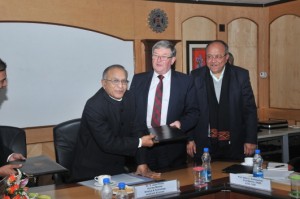5th February 2013 New Delhi, India
Great chemistry between UK and India!
A former SIN Team member, Rajesh Parishwad, left to work for the Royal Society of Chemistry a couple of years ago. But we don’t like to lose touch with old friends and with Rajesh this isn’t difficult to achieve: he still sits in our office in Bangalore! Anyway, we asked Rajesh to bring you some news from his side of the desk…
Last week I was in Delhi for the signing of an MoU between the Council of Scientific and Industrial Research (CSIR) and the Royal Society of Chemistry (RSC). Our journey to CSIR HQ looked like it may be disrupted by Beating the Retreat (a colourful march past by presidential guards and music performed by defence bands – it is also marks end of Republic Day Celebrations) at Vijay Chowk. But some forward planning allowed us to skirt round the celebrations and reach our destination in good time.

In a similar vein, the partnership between CSIR and the RSC was developed quickly thanks to good interactions and speedy decisions. It was only October last year when the RSC had a meeting with the Open Source Drug Discovery (OSDD), an initiative of the CSIR. It was immediately clear there was a great connection and huge potential for joint collaborations.
The agreement was signed by RSC Immediate Past President David Phillips and OSDD Project Director Zakir Thomas in the presence of Indian Science Minister, Jaipal Reddy, Professor Samir Brahmachari, the Head of CSIR and the driver behind OSDD, Head of the UK Science and Innovation Network, Mark Sinclair, and the new Secretary to the Indian Department of Biotechnology Vijay Raghavan.
The CSIR and the RSC aim to build a community of researchers with the common aim of raising awareness of the importance of cheminformatics. The MoU, spanning three years, aims to address the objective of finding novel, faster-acting, and more effective regimens for TB and malaria by advancing the discipline of cheminformatics.
The collaboration envisions conducting workshops and conferences to build links between experts and leaders. It will focus on building an online repository of real and virtual molecular structures along with developing free-to -use software tools for drug discovery and development. It also aims at exploring the possibility of advancing OSDD’s e-learning program for students.
Through this agreement, the CSIR and RSC are responding to the challenge of ‘lost data’ – that is the 90% of research output that never gets published. Professor Phillips said “That data, that information, that knowledge, is lost to society. But it has enormous value to the chemical science research community and by using new tools and new disciplines, like cheminformatics or e-Science, we can recapture that lost information. The importance of cheminformatics in addressing this challenge cannot be underestimated.”
Delivering the scientific talk, Professor Brahmachari said that, since its inception, the OSDD had grown with great support within India and outside and the scope of the work has expanded tremendously. “What we cannot do alone, we with complementary skills, need to work together. Finding new drugs for TB is a major challenge. We are joining hands to find New Chemical Entities which could be potential anti-TB drugs.”
Last week, the RSC also held its 7th joint symposium with the Chemical Research Society of India at Banaras Hindu University in Varanasi. It attracted over 450 participants and the British Council and RSC supported 10 PhD research fellows to participate and deliver presentations.
And this week, we are touring with two dozen Indian speakers and a dozen international speakers including Professor George Whitesides (all of them scientific editors of RSC journals across India). We will hold scientific symposia at the Indian Association for Cultivation of Sciences in Kolkata on the 5th; at Indian Institute of Sciences in Bangalore on the 7th; and at the National Chemical Laboratory on 11th. We’ll be showcasing the best research in India and around the world.
There’s so much happening. And there’s even more to come. As we see an incredible and rapid expansion of chemical sciences in India, and we see the opportunity to build on many years’ work here, we’re looking to step it up a gear.
Rajesh Parishwad